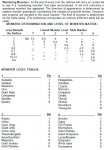Neonchameleon
Legend
As I recall, Tomb of Horrors was deliberately written for high level characters and he wrote Tomb of Horrors , because a lot of people were bragging about their high level characters despite having not played nearly as long as his own players whose characters were not nearly as high a level. ToH was easy way to smack down those players and demonstrate that the players had not the skill to have earned characters of such high level
Close.
It was his own players (Rob Kuntz and Ernie Gygax) doing the bragging claiming that everything in Greyhawk was too easy. So he wrote ToH to be as hard as possible.
Net result: They completed it, taking all the treasure, and without losing any PCs.
(There's actually a pretty simple trick to beating ToH that if you know it makes it very easy. They knew Gygax well enough to guess it).



